Predict the Suitable Places to Run in the Urban Area of Beijing by Using the Maximum Entropy Model
Abstract
:1. Introduction
2. Materials and Methods
2.1. Materials
2.1.1. Running Routes
2.1.2. Natural Environment Variables
2.1.3. Street Variables
2.2. Methods
2.2.1. MaxEnt Modeling
2.2.2. Ripley’s K Function
2.2.3. Variables Calculation
2.2.4. Variables’ Correlation
2.2.5. Model Validation
3. Results
3.1. Results
3.1.1. Spatial Aggregation Analysis of Running Track Points
3.1.2. Variables Analysis
3.1.3. Running Suitability Map
3.1.4. The Relationship between Environmental Variables and Running Suitability Values
3.1.5. Spatial Mismatch between High Population Density and Low Running Suitability Values
4. Discussions
4.1. Validation
4.2. Advice on Running Routes Planning
4.3. Limitations
5. Conclusions
Author Contributions
Funding
Institutional Review Board Statement
Informed Consent Statement
Data Availability Statement
Conflicts of Interest
References
- US Department of Health Human Services. US Department of Health and Human Services 2008 Physical Activity Guidelines for Americans; J. Elite Esthetics: Hyattsville, MD, USA; Washington, DC, USA, 2008; pp. 1–40. [CrossRef]
- WHO. Global Recommendations on Physical Activity for Health; World Health Organization: Geneva, Switzerland, 2010; Available online: https://www.who.int/publications/i/item/9789241599979 (accessed on 1 April 2021).
- Warburton, D.E.; Charlesworth, S.; Ivey, A.; Nettlefold, L.; Bredin, S.S. A systematic review of the evidence for Canada’s Physical Activity Guidelines for Adults. Int. J. Behav. Nutr. Phys. Act. 2010, 7, 39. [Google Scholar] [CrossRef] [PubMed] [Green Version]
- Friedenreich, C.M.; Neilson, H.K.; Lynch, B. State of the epidemiological evidence on physical activity and cancer prevention. Eur. J. Cancer 2010, 46, 2593–2604. [Google Scholar] [CrossRef]
- Nocon, M.; Hiemann, T.; Muller-Riemenschneider, F.; Thalau, F.; Roll, S.; Willich, S.N. Association of physical activity with all-cause and cardiovascular mortality: A systematic review and meta-analysis. Eur. J. Cardiovasc. Prev. Rehabilit. 2008, 15, 239–246. [Google Scholar] [CrossRef] [PubMed]
- Hallal, P.C.; Andersen, L.B.; Bull, F.C.; Guthold, R.; Haskell, W.; Ekelund, U. Global physical activity levels: Surveillance progress, pitfalls, and prospects. Lancet 2012, 380, 247–257. [Google Scholar] [CrossRef]
- Brockmann, D.; Hufnagel, A.L.; Geisel, T. The scaling laws of human travel. Nat. Cell Biol. 2006, 439, 462–465. [Google Scholar] [CrossRef] [PubMed]
- González, M.C.; Hidalgo, C.A.; Barabasi, A. Understanding individual human mobility patterns. Nat. Cell Biol. 2008, 453, 779–782. [Google Scholar] [CrossRef] [PubMed]
- Rhee, I.; Shin, M.; Hong, S.; Lee, K.; Kim, S.J.; Chong, S. On the Levy-Walk Nature of Human Mobility. IEEE/ACM Trans. Netw. 2011, 19, 630–643. [Google Scholar] [CrossRef]
- Ornstein, K.; Galea, S. Teaching Epidemiology: A Guide for Teachers in Epidemiology, Public Health and Clinical Medicine. Third Edition: Edited by Jorn Olsen, Rodolfo Saracci, and Dimitrios Trichopoulos. Am. J. Epidemiol. 2010, 172, 1207–1208. [Google Scholar] [CrossRef]
- Rhodes, E.R.; Smith, N.E.I. Personality correlates of physical activity: A review and meta-analysis. Br. J. Sports Med. 2006, 40, 958–965. [Google Scholar] [CrossRef] [Green Version]
- Craggs, C.; Corder, K.; van Sluijs, E.; Griffin, S.J. Determinants of Change in Physical Activity in Children and Adolescents: A Systematic Review. Am. J. Prev. Med. 2011, 40, 645–658. [Google Scholar] [CrossRef] [Green Version]
- Rhodes, R.E.; Martin, A.D.; Taunton, J.E.; Rhodes, E.C.; Donnelly, M.; Elliot, J. Factors Associated with Exercise Adherence Among Older Adults. Sports Med. 1999, 28, 397–411. [Google Scholar] [CrossRef]
- Sallis, J.F.; Prochaska, J.J.; Taylor, W.C. A review of correlates of physical activity of children and adolescents. Med. Sci. Sports Exerc. 2000, 32, 963–975. [Google Scholar] [CrossRef] [PubMed]
- Cummins, S.; Curtis, S.; Diez-Roux, A.V.; Macintyre, S. Understanding and representing ‘place’ in health research: A relational approach. Soc. Sci. Med. 2007, 65, 1825–1838. [Google Scholar] [CrossRef]
- Matthews, S.A. The salience of neighborhood: Some lessons from sociology. Am. J. Prev. Med. 2008, 34, 257–259. [Google Scholar] [CrossRef] [PubMed]
- Myers, C.A.; Denstel, K.D.; Broyles, S.T. The context of context: Examining the associations between healthy and unhealthy measures of neighborhood food, physical activity, and social environments. Prev. Med. 2016, 93, 21–26. [Google Scholar] [CrossRef] [PubMed] [Green Version]
- Widener, M.J.; Farber, S.; Neutens, T.; Horner, M.W. Using urban commuting data to calculate a spatiotemporal accessibility measure for food environment studies. Heal Place 2013, 21, 1–9. [Google Scholar] [CrossRef] [PubMed] [Green Version]
- Sallis, J.F.; Cervero, R.B.; Ascher, W.; Henderson, K.A.; Kraft, M.K.; Kerr, J. An Ecological Approach to Creating Active Living Communities. Annu. Rev. Public Heal. 2006, 27, 297–322. [Google Scholar] [CrossRef] [PubMed] [Green Version]
- Krizek, K.J. Residential Relocation and Changes in Urban Travel: Does Neighborhood-Scale Urban Form Matter? J. Am. Plan. Assoc. 2003, 69, 265–281. [Google Scholar] [CrossRef]
- Seneviratne, P.N.; Morrall, J.F. Analysis of factors affecting the choice of route of pedestrians. Transp. Plan. Technol. 1985, 10, 147–159. [Google Scholar] [CrossRef]
- Badland, H.M.; Keam, R.; Witten, K.; Kearns, R. Examining Public Open Spaces by Neighborhood-Level Walkability and Deprivation. J. Phys. Act. Heal. 2010, 7, 818–824. [Google Scholar] [CrossRef]
- Frank, L.D.; Sallis, J.F.; Saelens, B.; Leary, L.; Cain, K.; Conway, T.L.; Hess, P.M. The development of a walkability index: Application to the Neighborhood Quality of Life Study. Br. J. Sports Med. 2009, 44, 924–933. [Google Scholar] [CrossRef] [PubMed]
- Dallat, M.A.T.; Soerjomataram, I.; Hunter, R.F.; Tully, M.A.; Cairns, K.J.; Kee, F. Urban greenways have the potential to increase physical activity levels cost-effectively. Eur. J. Public Health 2013, 24, 190–195. [Google Scholar] [CrossRef] [PubMed] [Green Version]
- Thompson, C.W. Activity, exercise and the planning and design of outdoor spaces. J. Environ. Psychol. 2013, 34, 79–96. [Google Scholar] [CrossRef] [Green Version]
- White, M.P.; Pahl, S.; Ashbullby, K.; Herbert, S.; Depledge, M.H. Feelings of restoration from recent nature visits. J. Environ. Psychol. 2013, 35, 40–51. [Google Scholar] [CrossRef]
- Kelly, C.; Tight, M.; Hodgson, F.; Page, M. A comparison of three methods for assessing the walkability of the pedestrian environment. J. Transp. Geogr. 2011, 19, 1500–1508. [Google Scholar] [CrossRef]
- Doherty, A.R.; Kelly, P.; Kerr, J.; Marshall, S.J.; Oliver, M.; Badland, H.; Foster, C. Use of wearable cameras to assess population physical activity behaviours: An observational study. Lancet 2012, 380, S35. [Google Scholar] [CrossRef]
- Kelly, P.; Doherty, A.; Berry, E.; Hodges, S.; Batterham, A.M.; Foster, C. Can we use digital life-log images to investigate active and sedentary travel behaviour? Results from a pilot study. Int. J. Behav. Nutr. Phys. Act. 2011, 8, 1–9. [Google Scholar] [CrossRef] [Green Version]
- Dunton, G.F.; Almanza, E.; Jerrett, M.; Wolch, J.; Pentz, M.A. Neighborhood Park Use by Children. Am. J. Prev. Med. 2014, 46, 136–142. [Google Scholar] [CrossRef] [Green Version]
- Evenson, K.R.; Wen, F.; Hillier, A.; Cohen, D.A. Assessing the Contribution of Parks to Physical Activity Using Global Positioning System and Accelerometry. Med. Sci. Sports Exerc. 2013, 45, 1981–1987. [Google Scholar] [CrossRef] [Green Version]
- Kaczynski, A.T.; Potwarka, L.R.; Smale, B.J.A.; Havitz, M.E. Association of Parkland Proximity with Neighborhood and Park-based Physical Activity: Variations by Gender and Age. Leis. Sci. 2009, 31, 174–191. [Google Scholar] [CrossRef]
- Norman, P.; Pickering, C.M.; Castley, G. What can volunteered geographic information tell us about the different ways mountain bikers, runners and walkers use urban reserves? Landsc. Urban Plan. 2019, 185, 180–190. [Google Scholar] [CrossRef]
- Lafortezza, R.; Carrus, G.; Sanesi, G.; Davies, C. Benefits and well-being perceived by people visiting green spaces in periods of heat stress. Urban For. Urban Green. 2009, 8, 97–108. [Google Scholar] [CrossRef]
- Pretty, J.; Peacock, J.; Sellens, M.; Griffin, M. The mental and physical health outcomes of green exercise. Int. J. Environ. Health Res. 2005, 15, 319–337. [Google Scholar] [CrossRef] [PubMed]
- Sallis, J.F.; Owen, N.; Fotheringham, M.J. Behavioral epidemiology: A systematic framework to classify phases of research on health promotion and disease prevention. Ann. Behav. Med. 2000, 22, 294–298. [Google Scholar] [CrossRef] [PubMed]
- Yang, Y.; TANG, X.; Liu, J.; Lu, S. Urban Street Health Service Function Based on Mobile Fitness Data. Landsc. Archit. 2018, 25, 18–23. [Google Scholar] [CrossRef]
- Moreno, R.; Ojeda, N.; Azócar, J.; Venegas, C.; Inostroza, L. Application of Ndvi for Identify Potentiality of the Urban Forest for the Design of a Green Corridors System in Intermediary Cities of Latin America: Case Study, Temuco, Chile. Urban For. Urban Green. 2020, 55, 126821. [Google Scholar] [CrossRef]
- Kappes, H.; Katzschner, L.; Nowak, C. Urban summer heat load: Meteorological data as a proxy for metropolitan biodiversity. Meteorol. Z. 2012, 21, 525–528. [Google Scholar] [CrossRef]
- Brown, B.B.; Werner, C.M.; Amburgey, J.W.; Szalay, C. Walkable Route Perceptions and Physical Features. Environ. Behav. 2007, 39, 34–61. [Google Scholar] [CrossRef]
- Ricker, B. International Encyclopedia of Human Geography, 2nd ed.; Elsevier: Amsterdam, The Netherlands, 2020; pp. 187–195. [Google Scholar] [CrossRef]
- Jaynes, E.T. Information Theory and Statistical Mechanics. II. Phys. Rev. 1957, 108, 171–190. [Google Scholar] [CrossRef]
- Shipley, B. Limitations of entropy maximization in ecology: A reply to Haegeman and Loreau. Oikos 2009, 118, 152–159. [Google Scholar] [CrossRef]
- Dixon, P.M. Ripley’s K function. Encycl. Environ. 2001, 3, 1796. [Google Scholar]
- Garrocho-Rangel, C.; Álvarez-Lobato, J.A.; Chávez, T. Calculating Intraurban Agglomeration of Economic Units with Planar and NetworkK-Functions: A Comparative Analysis. Urban Geogr. 2013, 34, 261–286. [Google Scholar] [CrossRef]
- Lu, Y.; Chen, X. On the false alarm of planar K-function when analyzing urban crime distributed along streets. Soc. Sci. Res. 2007, 36, 611–632. [Google Scholar] [CrossRef]
- Ardestani, E.G.; Mokhtari, A. Modeling the lumpy skin disease risk probability in central Zagros Mountains of Iran. Prev. Veter Med. 2020, 176, 104887. [Google Scholar] [CrossRef] [PubMed]
- Greiner, M.; Pfeiffer, D.; Smith, R. Principles and practical application of the receiver-operating characteristic analysis for diagnostic tests. Prev. Veter Med. 2000, 45, 23–41. [Google Scholar] [CrossRef]
- Li, Q.; Ren, H.; Zheng, L.; Cao, W.; Zhang, A.; Zhuang, D.; Lu, L.; Jiang, H. Ecological Niche Modeling Identifies Fine-Scale Areas at High Risk of Dengue Fever in the Pearl River Delta, China. Int. J. Environ. Res. Public Heal 2017, 14, 619. [Google Scholar] [CrossRef] [Green Version]
- Karimi, K. A configurational approach to analytical urban design: ‘Space syntax’ methodology. Urban Des. Int. 2012, 17, 297–318. [Google Scholar] [CrossRef]
- Liu, K.; Siu, K.W.M.; Gong, X.Y.; Gao, Y.; Lu, D. Where do networks really work? The effects of the Shenzhen greenway network on supporting physical activities. Landsc. Urban Plan. 2016, 152, 49–58. [Google Scholar] [CrossRef] [Green Version]
- WHO. Global Age-Friendly Cities: A Guide; World Health Organization: Geneva, Switzerland, 2007. [Google Scholar] [CrossRef]
- Elwood, S.; Goodchild, M.F.; Sui, D.Z. Researching Volunteered Geographic Information: Spatial Data, Geographic Research, and New Social Practice. Ann. Assoc. Am. Geogr. 2012, 102, 571–590. [Google Scholar] [CrossRef]
- Goodchild, M.F.; Li, L. Assuring the quality of volunteered geographic information. Spat. Stat. 2012, 1, 110–120. [Google Scholar] [CrossRef]
- Fitzhugh, E.C.; Bassett, D.R.; Evans, M.F. Urban Trails and Physical Activity. Am. J. Prev. Med. 2010, 39, 259–262. [Google Scholar] [CrossRef] [PubMed]
- Andersen, H.B.; Christiansen, L.B.; Klinker, C.D.; Ersbøll, A.K.; Troelsen, J.; Kerr, J.; Schipperijn, J. Increases in Use and Activity Due to Urban Renewal: Effect of a Natural Experiment. Am. J. Prev. Med. 2017, 53, e81–e87. [Google Scholar] [CrossRef] [PubMed]


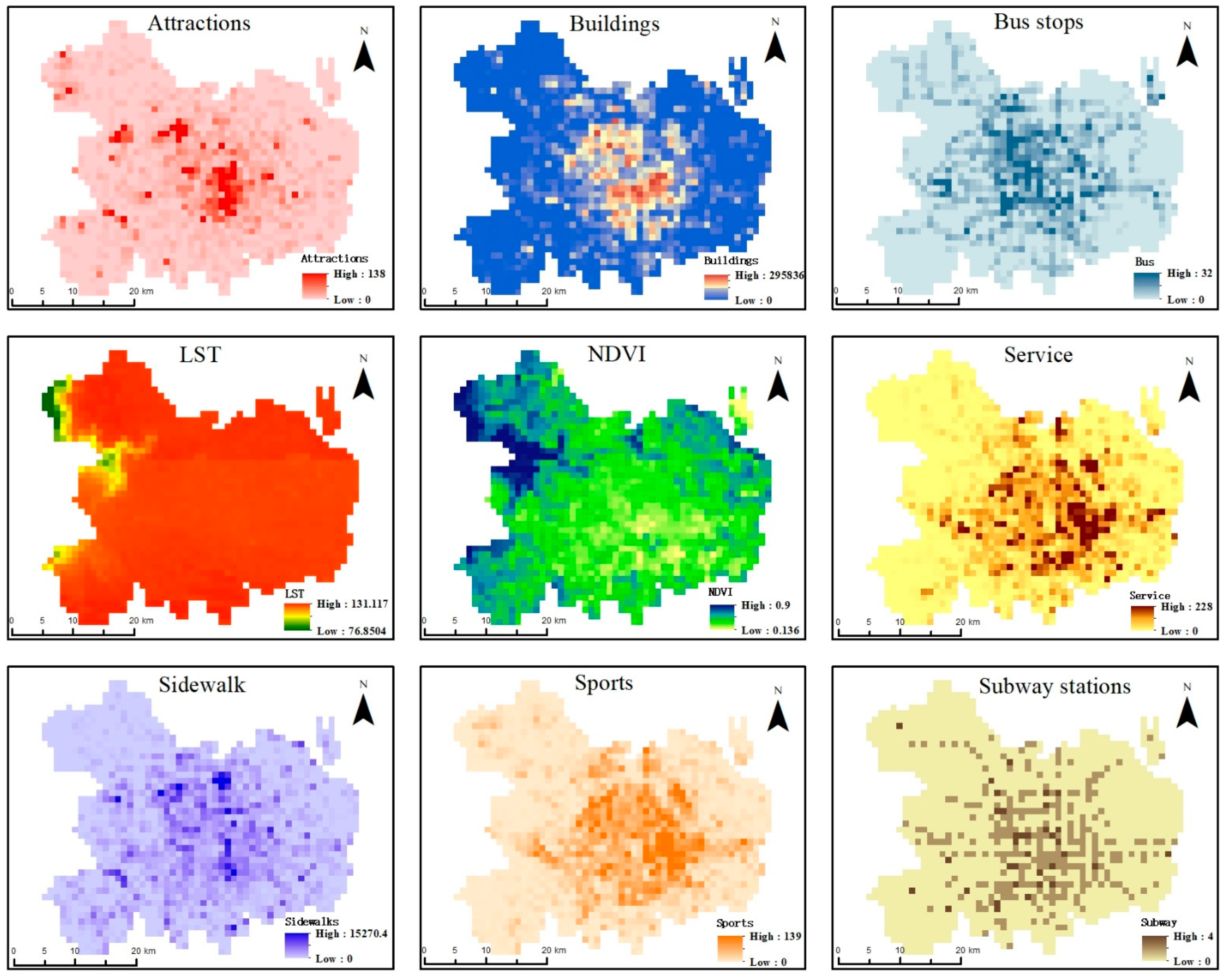

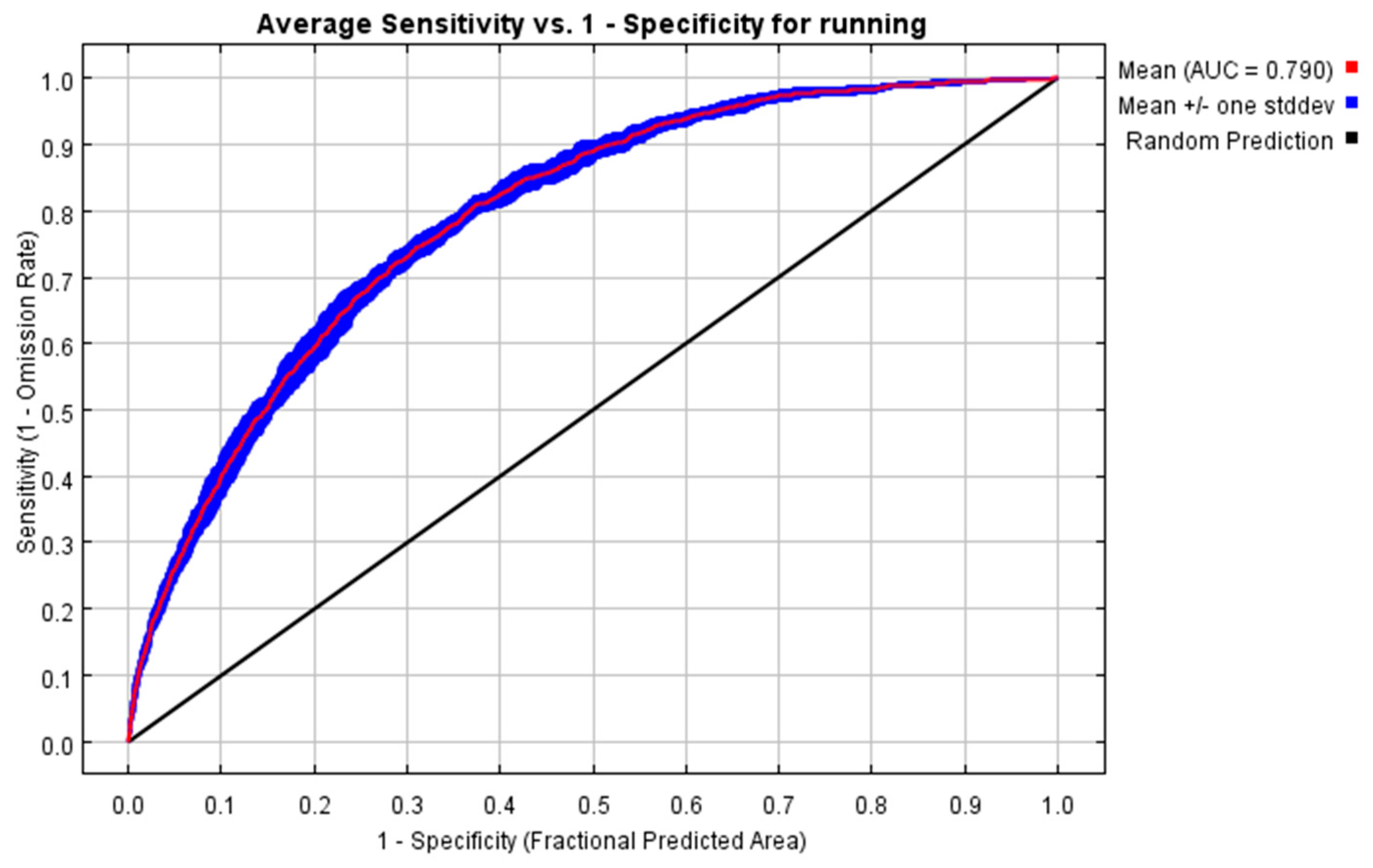
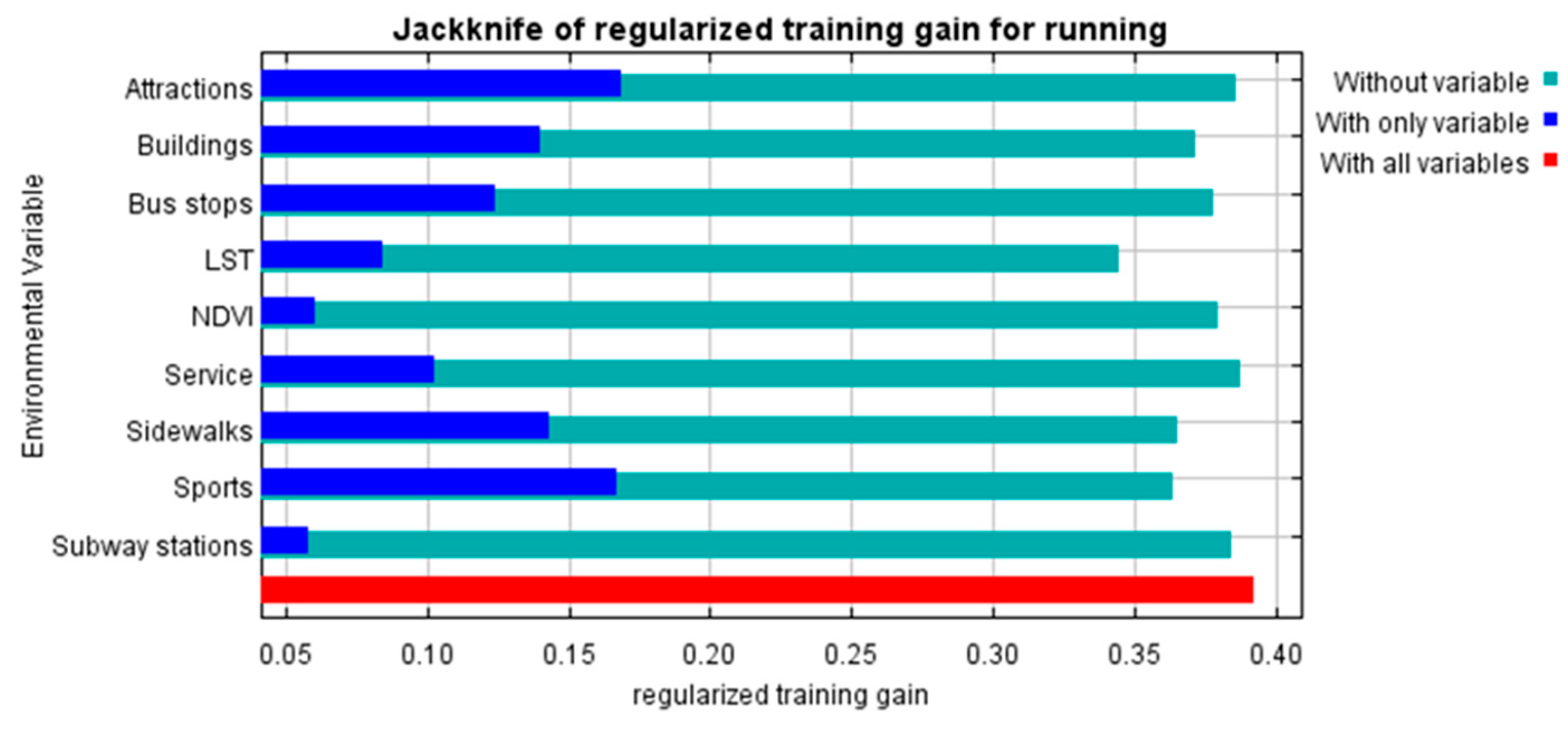
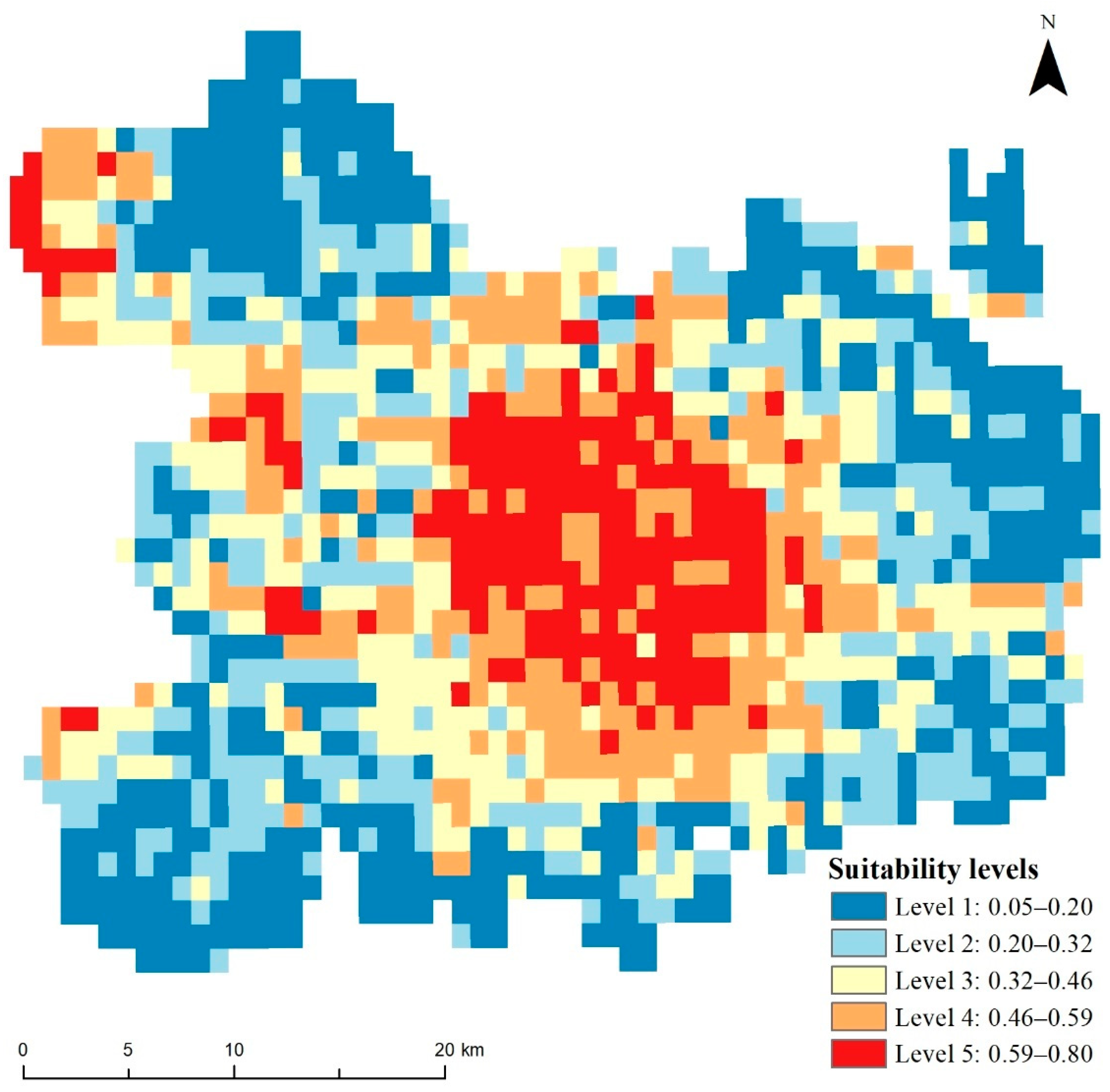

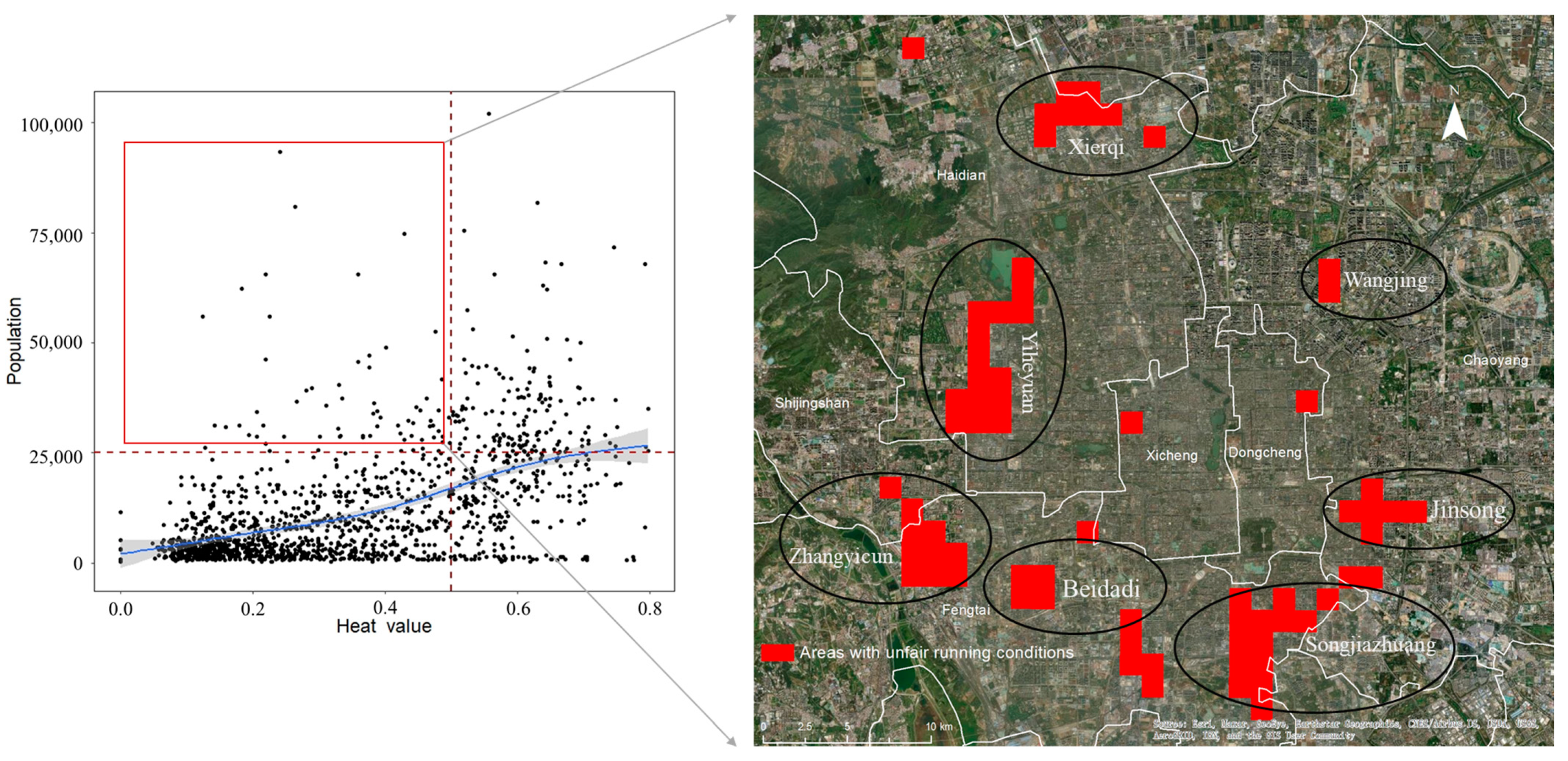
| ID | Route Descriptions | Tags | Avg Speed (km/h) | Users Count | Avg Age |
|---|---|---|---|---|---|
| 1 | Regular exercise | [road, exercise, flat, high, marked] | 7.85 | 25 | 33 |
| 2 | Behai park around once | [asphalt, exercise, flat, high, accessible] | 9.14 | 16 | 31 |
| 3 | 10 km including north and south park | [trail, exercise, flat, normal, accessible] | 10.18 | 11 | 34 |
| 4 | From the company to Forest Park | [road, exercise, undulating, less, accessible] | 12.78 | 7 | 24 |
| 5 | Two half marathon in North South Park of Orson | [road, exercise, undulating, normal, marked] | 6.7 | 7 | 30 |
| Variables | Data Descriptions | Data Size | Data Sources |
|---|---|---|---|
| Running routes | Preferred running routes, data acquisition year is 2017 | 153 routes | Adidas Runtastic: https://www.Runtastic.com/, accessed on 1 April 2020 |
| LST | Land Surface Temperature, 2017 | 1537 grids (1 km × 1 km) | https://developers.google.com/earth-engine/datasets/catalog/MODIS_006_MOD11A1, accessed on 1 April 2020 |
| NDVI | Normal Difference Vegetation index, 2017 | 1537 grids (1 km × 1 km) | https://developers.google.com/earth-engine/datasets/catalog/MODIS_MOD09GA_006_NDVI, accessed on 1 April 2020 |
| Buildings | The density of the area of buildings, 2018 | 52,221 polygons | Open Street Map: https://download.geofabrik.de/asia.html, accessed on 1 April 2020 |
| Length of Sidewalks | The density of sidewalks used for exercise, 2018 | 26,889 lines | Gaode Map: https://lbs.amap.com/demo/jsapi-v2/example/layers/roadnet/, accessed on 1 June 2019 |
| Attractions | The density of scenic spots, squares, parks, 2018 | 3786 points | Points of interest (POI) from Gaode Map: https://lbs.amap.com/api/android-sdk/guide/map-data/poi/, accessed on 1 June 2019 |
| Bus stops | The density of bus stops | 3424 points | |
| Service | The density of personal cares, convenience business supers, express points, 2018 | 28,390 points | |
| Sports | The density of gyms, gymnasiums, activity centers, 2018 | 15,893 points | |
| Subway stations | The density of subway stations, the data date is 2018 | 329 points |
Publisher’s Note: MDPI stays neutral with regard to jurisdictional claims in published maps and institutional affiliations. |
© 2021 by the authors. Licensee MDPI, Basel, Switzerland. This article is an open access article distributed under the terms and conditions of the Creative Commons Attribution (CC BY) license (https://creativecommons.org/licenses/by/4.0/).
Share and Cite
Song, L.; Zhang, A. Predict the Suitable Places to Run in the Urban Area of Beijing by Using the Maximum Entropy Model. ISPRS Int. J. Geo-Inf. 2021, 10, 534. https://doi.org/10.3390/ijgi10080534
Song L, Zhang A. Predict the Suitable Places to Run in the Urban Area of Beijing by Using the Maximum Entropy Model. ISPRS International Journal of Geo-Information. 2021; 10(8):534. https://doi.org/10.3390/ijgi10080534
Chicago/Turabian StyleSong, Liuyi, and An Zhang. 2021. "Predict the Suitable Places to Run in the Urban Area of Beijing by Using the Maximum Entropy Model" ISPRS International Journal of Geo-Information 10, no. 8: 534. https://doi.org/10.3390/ijgi10080534
APA StyleSong, L., & Zhang, A. (2021). Predict the Suitable Places to Run in the Urban Area of Beijing by Using the Maximum Entropy Model. ISPRS International Journal of Geo-Information, 10(8), 534. https://doi.org/10.3390/ijgi10080534







